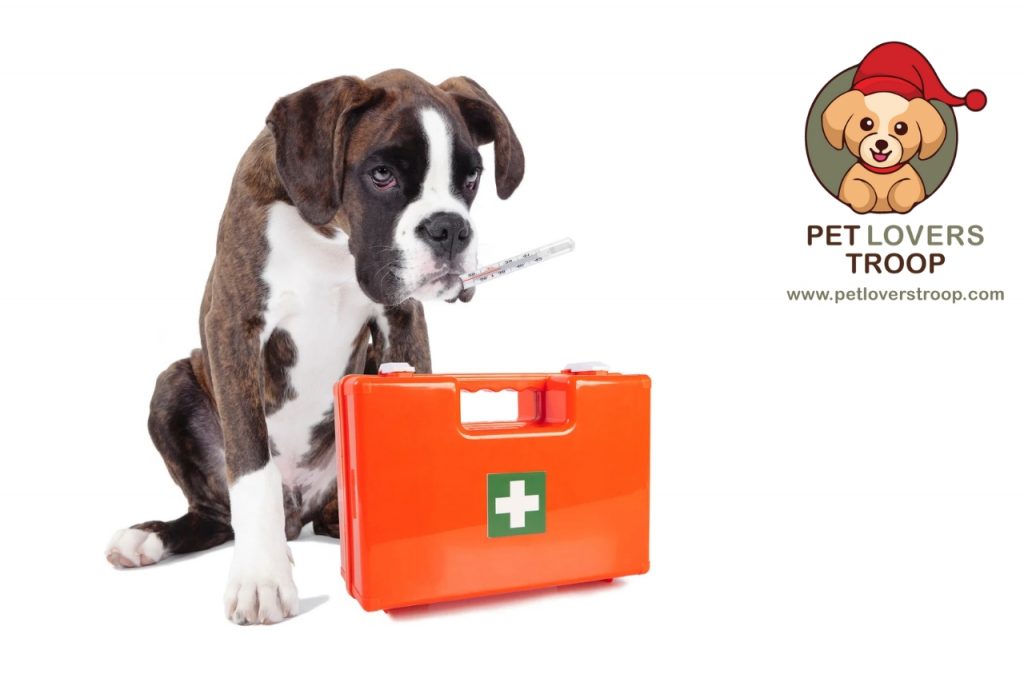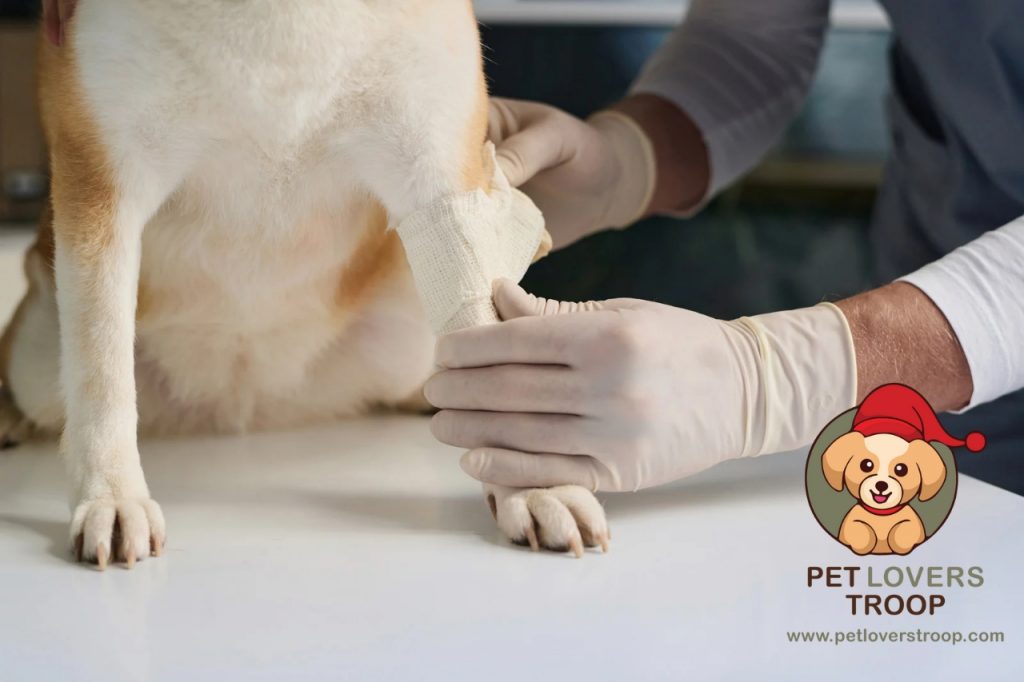Do you have all the pet first aid basics? The plan was for it to be another quiet weekend. After getting up early, Adeel grabbed some refreshments. He fastened Luna’s leash and made his way to the Margalla Hills. Luna loved going on these excursions. It was her first time outside. She sniffed every blossom, ran through muddy places, and barked joyfully at birds.
However, halfway through, Luna let out a startled cry of agony. She had blood dripping from her paw when Adeel hurried over. The rock she had trodden on was jagged. She was limping severely, and the gash appeared to be deep. Adeel stopped.
He was without water. No dressings. Not even tissues. He went into a panic. He made a makeshift wrap out of his shirt. Before arriving at the automobile, he held her in his arms for almost twenty-five minutes.
At the vet, the doctor cleaned the wound and stitched her up. But the vet’s words hit hard: “A little pet first aid could have made this a lot easier for both of you.”
That day changed Adeel. He started reading about pet first aid basics. He built a first aid kit. He learned how to stop bleeding, calm a dog in pain, and respond to choking. He realized emergencies don’t just happen to other people. They can happen to you. When they do, every second counts.

What You’ll Learn in This Pet First Aid Basics Guide
When your dog gets hurt, there’s no time to Google. You need to act fast. This guide is here to help you feel ready, not overwhelmed. We’ll walk you through the most important pet first aid basics that every dog owner should know.
That includes spotting warning signs, managing common injuries, performing canine CPR, and building a solid pet first aid kit. You’ll also learn how to recognize real emergencies.
Not every sneeze is a crisis. Some symptoms are louder than they look. We’ll break it section by section, using simple steps and real stories from dog owners who’ve been there. So whether you’ve had dogs for years or just bought a new pup home, this is for you. First aid isn’t just for the worst-case scenario. It’s for every scraped paw, allergic reaction, or moment of panic. It’s for peace of mind.
Read more: Best Nail Cutter for Dogs to Safely Use at Home
Recognizing Pet Health Emergencies
Dogs are brave. Too brave sometimes. They don’t whine when something’s wrong. They might limp for a bit, then act normal. They might stop eating but still wag their tail. That’s what makes spotting danger so tricky. But as a pet parent, you have to tune in. Watch for patterns.
A cough here and there might not mean much. But a cough that keeps getting worse? That’s different. Vomiting once isn’t a red flag. Vomiting multiple times in a day? That’s a warning. Signs of a real emergency often include non stop vomiting or diarrhea, heavy bleeding, labored breathing, bloating, sudden collapse, or unresponsiveness.
If your dog is staring at the wall, can’t stand, or shows signs of confusion they need help fast. The American Veterinary Medical Association reports that one in four pets could survive emergencies if owners acted quickly with first aid. That means recognizing danger isn’t just important. It’s life-saving. When in doubt, don’t wait. Call your vet. Trust your gut.

Canine CPR Techniques
Imagine this: your dog is lying still. No breathing. No movement and heartbeat. It’s your worst nightmare but it happens. When it does, canine CPR techniques can be your only shot. Dog CPR works differently than human CPR, but the idea is the same: keep oxygen and blood flowing.
Start by laying your dog on their right side. Place the heel of your palm on the widest part of the chest, near the heart. Press hard and fast about 30 compressions in a quick rhythm. After compressions, gently close their mouth and breathe into their nose twice.
Read more: Traveling with Pets: How to Make Trips Safe and Stress-Free – March 2025
If your dog doesn’t respond, continue for up to 20 minutes or until you can get to emergency care. You may never need it but if you do, this knowledge can make you the reason your dog gets another chance. Mojo, a chubby little pug in Karachi, owes his life to CPR.
He choked on a chicken bone one evening and collapsed. His owner, Hira, had watched a CPR tutorial online weeks before. When panic struck, she remembered the steps. Her quick action brought him back. That moment turned fear into relief and panic into power.
Dog Emergency Care
Emergencies are loud and sudden. But what your dog needs most in that moment is your calm. To do so by your veterinarian if they have consumed anything toxic. Remain with them. Talk quietly. Gently touch. If necessary, carry them while maintaining a straight spine.
Their comfort comes from your energy. Rex, a German shepherd passed out from heat stroke. Fahad, his owner, refrained from screaming or phoning everyone in a panic. He bundled Rex after carrying him to the car. That small window of calm made all the difference before they reached the clinic.
Read more: How to Introduce a New Pet to Your Home: A Guide to Introducing a New Pet – March 2025
Pet First Aid Kit Essentials
A pet first aid kit is like your dog’s emergency backpack. It doesn’t have to be big. But it needs to be ready. At home. In the car. On road trips. Everywhere your dog goes. Start with gauze for wrapping wounds. Rex, a German shepherd, died of heat stroke while out on a long stroll in Lahore.
Fahad, who owned him, did not yell or call everyone in a panic. He carried Rex to the car and wrapped him. That brief moment of peace and quiet was crucial before they arrived at the clinic. Add a digital thermometer, antiseptic wipes, and sticky tape. Include tweezers for splinters and ticks.
Bring some saline solution to rinse cuts or eyes. Add a towel, gloves, and a muzzle. Don’t forget emergency numbers. Write down your vet’s contact. Save the local 24-hour animal hospital number in your phone. Keep it in the kit too. If your dog takes regular medication, put a backup dose inside.
Zoya, who runs a rescue shelter, once saved a puppy’s eye using saline from her kit. That bottle cost less than a cup of coffee. But it saved a life. That’s the power of preparation.
Read more: Pet First Aid 101.
Handling Pet Injuries
Injuries are part of life with dogs. But what you do in the first few minutes matters most. Rinse the wound gently. Use saline or clean water. Pat it dry. Wrap it with gauze. Don’t let them lick it. Keep them calm. If there’s swelling or limping, apply a cold compress. Stop them from walking.
Carry them if needed. Even a small limp can turn into a big injury if ignored. If something is stuck in their body glass, metal, thorns don’t yank it out. That can cause bleeding. Stabilize the object and take them straight to the vet. Nida’s beagle, Daisy, once got caught in barbed wire. She didn’t panic.
She wrapped the paw in a cloth and made her way to the car. Her calm saved Daisy from infection and further trauma. This is what handling pet injuries looks like: gentle steps. Sharp thinking. Quiet strength.
Pet First Aid Basics in Daily Life
Pet first aid basics aren’t just for disasters. It’s for daily care. It’s for being present and prepared. Feel your dog body during cuddles. Check for swelling, ticks, or sore spots. Watch how they walk. Listen to how they breathe. Notice if their appetite drops. These are signs. Early ones. Know their baseline.
A dog’s normal temperature is around 101–102.5°F. Pulse should be between 60–140 beats per minute, depending on size. Learn these numbers. That way, you’ll catch problems before they grow. Make health checks a weekly habit. Keep one pet first aid kit in your car and another at home.
Review it monthly. Restock what’s missing. Even kids can help. Teach them how to notice limping or sneezing. Show them how to be calm around an injured dog. These little steps create confident caretakers.

Conclusion
Your dog isn’t just a pet. They’re your shadow, your comfort, your family. They trust you with their whole heart. From meals to walks to bedtime snuggles you are their world. But when something scary happens, they need you in a different way.
Pet first aid basics aren’t just practical skills. They’re a promise. A promise to stay calm when they panic. To act when they freeze. To help when every second counts. Your knowledge becomes their safety net.
Whether it’s a small cut, a choking scare, or something you never expected, your response can change everything. Knowing canine CPR techniques or what goes into a proper pet first aid kit puts power in your hands.
Emergencies don’t wait. Now, you won’t either. Because when a crisis hits, your dog doesn’t need a superhero. They need you. Focused. Steady. Ready to step in when it matters most.

